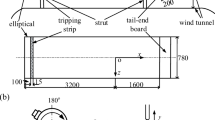Abstract
An experimental study of a three-dimensional, pressuredriven, attached turbulent boundary-layer flow was made at Mach 0.4. Both the mean velocities and the full Reynolds stress tensor were measured simultaneously by a three-component LDA system. Value of the resultant shear stress to turbulent kinetic energy ratio varied between 0.1 and 0.2 and did not remain constant across the boundary-layer. Slopes of the streamwise and azimuthal mixing length distributions in the wall region were around 0.4 and 1.2, respectively. Skew angle of the turbulent shear stress was larger than skew angle of the velocity gradient.
Similar content being viewed by others
References
Bachalo, W. D.; Johnson, D. A. 1979: An investigation of transonic turbulent boundary layer separation generated on an axisymmetric flow model. AIAA Pap. 79-1479
Bradshaw, P. 1971: Calculation of three-dimensional turbulent boundary layers. J. Fluid Mech. 46, 417–445
Cebeci, T. 1985: Problems and opportunities with three-dimensional boundary-layers. AGARD Rep. no. 719, 6.1–6.35
Driver, D. M.; Hebbar, S. K. 1987: Experimental study of a three-dimensional shear-driven turbulent boundary-layer. AIAA J. 25, 35–42
Elsenaar, A.; Berg, V. D.; Lindhout, J. P. F. 1975: Three-dimensional separation of an incompressible turbulent boundary-layer on an infinite swept wing. AGARD CP 168, 34.1–34.15
Fernholz, H. H.; Vagt, J. D. 1981: Turbulence measurements in an adverse-pressure-gradient three-dimensional turbulent boundary-layer along a circular cylinder. J. Fluid Mech. 111, 233–269
Galbraith, R. A. M.; Head, M. R. 1975: Eddy viscosity and mixing length from measured boundary-layer developments. Aeronaut. Q. 26, 133–154
Gülcat, U.; Aslan, A. R. 1987: A finite element-finite difference solution of three-dimensional viscous-inviscid interaction. (To be published in Commun. Appl. Numer. Meth.)
Johnston, J. P. 1976: Experimental studies in three-dimensional turbulent boundary-layers. Stanford University, Thermo. Div. Rep. MD-34
Klebanoff, P. S. 1955: Characteristics of turbulence in a boundarylayer with zero pressure gradient. NACA Rep. 1247
Müller, U. R. 1982: Measurements of the Reynolds stresses and the mean flow field in a three-dimensional pressure driven boundary-layer. J. Fluid Mech. 118, 121–155
Nakayama, A. 1985: Characteristics of the flow around conventional and supercritical airfoils. J. Fluid Mech. 160, 155–179
Özcan, O.; Johnson, D. A. 1985: A three component LDA system for turbulence and mean velocity measurements. Bull. Tech. Univ. Istanbul 39, 97–107
Özcan, O. 1987: Description and measurement accuracy of a 3D LDA system. Proc. ASME fluid measurements and instrumentation forum, Cincinatti OH, June 14–18, 1987
Patel, V. C. 1973: A unified view of the law of the wall using mixing length theory. Aeronaut. Q. 24, 55–70
Pierce, F. C.; McAllister, J. E.; Tennant, M. H. 1983: Near-wall similarity in a pressure-driven three-dimensional turbulent boundary-layer. J. Fluids Eng. 105, 257–262
Yanta, W. C.; Aushermann, D. W. 1983: The turbulence properties of a supersonic boundary-layer on a sharp cone at angle of attack. AIAA Pap. 83-0456
Author information
Authors and Affiliations
Rights and permissions
About this article
Cite this article
Özcan, O. Three-component LDA measurements in a turbulent boundary layer. Experiments in Fluids 6, 327–334 (1988). https://doi.org/10.1007/BF00538824
Received:
Issue Date:
DOI: https://doi.org/10.1007/BF00538824




